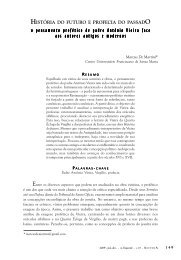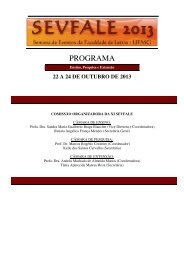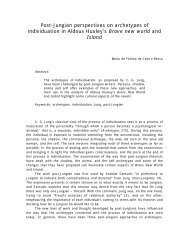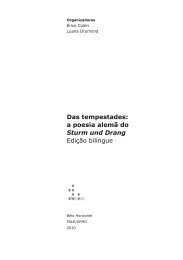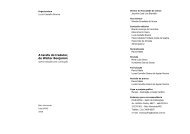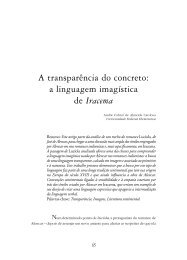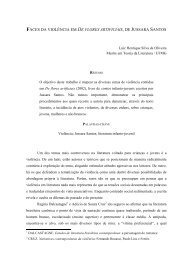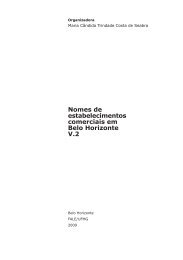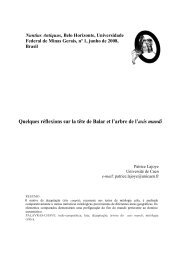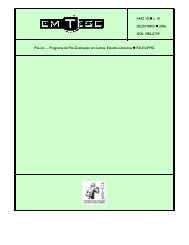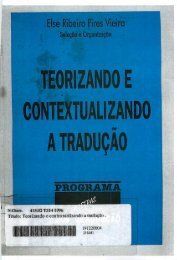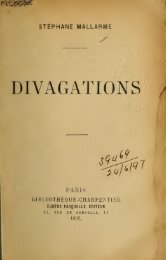E. E. Cummings: Modernist Painter and Poet
E. E. Cummings: Modernist Painter and Poet
E. E. Cummings: Modernist Painter and Poet
Create successful ePaper yourself
Turn your PDF publications into a flip-book with our unique Google optimized e-Paper software.
6 Noise Number 1, 1919. Oil on canvas, 36<br />
x 36 in. State University of New York<br />
College at Brockport Foundation<br />
7 Joseph Stella, Battle of Lights: Coney Isl<strong>and</strong>,<br />
1913. Oil on canzas, 76 x 84 in. Yale<br />
University Art Gallery, New Haven,<br />
Connecticut, Gift of Collection Societe<br />
Anonyme<br />
to the human form," he com-<br />
plained in 1918.11 Futurist dyna-<br />
mism nicely compensated Cubist<br />
stasis, but <strong>Cummings</strong> distrusted<br />
the Futurists' posturing bravado:<br />
early <strong>and</strong> late, he respected indi-<br />
viduals, not groups. Among Fu-<br />
turist-inspired American painters,<br />
he especially admired Joseph<br />
Stella (1880-1946) <strong>and</strong> John Marin<br />
(1870-1953). <strong>Cummings</strong> met<br />
Stella in 1919, <strong>and</strong> Stella's Battle<br />
of Lights: Coney Isl<strong>and</strong> (fig. 7)<br />
probably inspired the tangle of<br />
serpentine <strong>and</strong> jagged lines <strong>and</strong><br />
elliptical curves that <strong>Cummings</strong><br />
created a few months later in<br />
Noise Number 5. Like Stella,<br />
<strong>Cummings</strong> went to Coney Isl<strong>and</strong><br />
to "capture colour <strong>and</strong> motion."<br />
And like Marin, he found New<br />
York skyscrapers, such as the<br />
Woolworth Building (fig. 8), alive<br />
<strong>and</strong> dynamic-apt subjects for<br />
paintings such as New York, 1927<br />
(fig. 9) <strong>and</strong> its poetic counterpart<br />
"at the ferocious phenomenon of<br />
5 o'clock i find myself."12 For all<br />
their indebtedness, however,<br />
<strong>Cummings</strong>'s early abstractions re-<br />
tain their individuality in the way<br />
60 Spring 1990<br />
they transform these influences<br />
into a unique whole. Their poised<br />
tensions of planar solidity <strong>and</strong> dy-<br />
namism, of an abstract design <strong>and</strong><br />
its figurative origins, embody aes-<br />
thetic ideas <strong>Cummings</strong> had devel-<br />
oped in his notes <strong>and</strong> applied to<br />
his poetry as well.<br />
The public response to<br />
<strong>Cummings</strong>'s entries at the 1920 In-<br />
dependent exhibition must have<br />
exceeded his most optimistic ex-<br />
pectations. This time reviewers<br />
from four newspapers mentioned<br />
his paintings. One called them<br />
"a striking bit of post-impres-<br />
sionism." Another recommended<br />
that <strong>Cummings</strong>'s paintings be in-<br />
cluded in future exhibitions of ab-<br />
stract art. The most detailed re-<br />
view appeared in the Evening Post:<br />
E. E. <strong>Cummings</strong> entitles one of<br />
these [abstractions] "Noise Number<br />
5" <strong>and</strong> the other "Sound Number<br />
5". Of the two, we preferred the<br />
noise; both of them are interesting.<br />
Of course, these irregular patterns<br />
of sharp positive color are banners<br />
of a small army of theorists, <strong>and</strong><br />
the theories will either entrance



